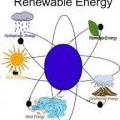AUSTRALIA is wasting agricultural byproducts and missing out on a clean energy source.
 A report from the Weekly Times.....
A report from the Weekly Times.....
According to renewable energy experts, Australia is now “lagging decades behind Europe and New Zealand”, having failed to develop a bioenergy sector.
And farmers and country Victorians are missing out as a result.
The experts say bioenergy — which can use straw, timber waste or even dead animals to create renewable energy — could rival coal seam gas as a “cost-efficient and less contentious energy source” without the environmental and water table risks that critics argue CSG has.
It could also create rural jobs and benefit farmers by providing new markets for byproducts such as straw.
Last month Beaufort Hospital installed a boiler that uses sawmill waste.
Horsham Council is considering a similar plant fuelled by reused timber products.
Ararat hospital is investigating a biomass plant and is considering a straw-burning boiler at Willaura hospital.
Ballarat and the Hepburn, Glenelg and southern Grampians shire councils are also looking into bioenergy.
Renewable energy expert Daryl Scherger led the Pyrenees Council’s project to install the Beaufort boiler which cost $600,000 (about $430,000 for the actual plant) and will save the hospital $40,000 annually in heating costs.
He said bioenergy was “cost competitive” but not yet as cheap as coal without more government incentives to kick start the industry.
He said the first thing governments could do to help stimulate a bioenergy industry in Victoria was to switch more rural public facilities on to bioenergy.
“Bioenergy is about a third of the cost of LPG for places like Beaufort,” he said.
“So if governments funded more bioenergy plants in rural hospitals and schools it would benefit them financially in the long-run and create the critical mass to get a local bioenergy industry up and going, which then could be used to supply other businesses as well.
“Australia lags everyone on bioenergy. New Zealand is far more advanced and we’re decades behind Europe.”
Mr Scherger said renewable bioenergy has fantastic opportunities for base load (continuous) power and heat and for creating far more rural jobs than wind or solar.
“Bioenergy is much cheaper than fossil fuels, even including the labour costs,” he said.
“And compared with wind or solar, it is very different because wind and solar cannot provide base load power. Bioenergy can provide base load power any time of the day or night, whether the wind is blowing or not.
“I live at Ararat. Only one person is employed for the big wind farm there, but a similar bioenergy project could help farmers and employ dozens of people and provide a regular workforce that adds to the economy.”
Mr Scherger said country Victoria’s resources for bioenergy were “enormous”, such as harvest trash from thousands of hectares of blue gums in western Victoria. Now, the trash was burnt in the paddock.
Australia’s failure to develop bioenergy was due to past access to cheap fossil fuels. Governments now needed to “create legislative framework for the sector to grow”.
“Governments here say they’re supportive, but don’t put much into practice,” Mr Scherger said.
World Bioenergy Association vice-president and Farm Forest Growers Victoria president Andrew Lang called on the Victorian Government to create policies to support the sector and provide “an honest broker, reliable information source” for those wishing to develop bioenergy.
A spokeswoman for Victorian Environment Minister Ryan Smith said the Government “welcomed investments into waste-to-energy technologies”.
“The State Government continues to support projects through facilitation,” she said.
“For example, helping Horsham Aquatic Centre to undertake a similar project to the one at Beaufort Hospital.”



